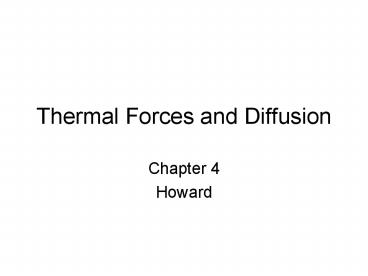Thermal Forces and Diffusion PowerPoint PPT Presentation
1 / 11
Title: Thermal Forces and Diffusion
1
Thermal Forces and Diffusion
- Chapter 4
- Howard
2
Thermal Forces and Diffusion
- Thermal Forces collisions with water and other
molecules in surrounding fluid, force results
from the change in momentum from the collision - Amplitude proportional the temperature
- Brownian motion diffusion of a free particle
- Forces high relative to protein conf. changes
allow to reach transition state - Boltzmans Law probability of a molecule having
a certain energy depends on the surrounding
temperature
3
Boltzmanns Law
- Probability, p, of finding the particle in state,
i, that has energy, U, is the Boltzmann constant
x temp (kT) - pi 1/Z exp-Ui/kT, where Z constant
?iexp-Ui/kT - The sum of all probabilities adds up to 1
- General Law applies to many different potential
energies, kinetic energy, electronic or chemical
state - State of a particle defined by position and
velocity of constituent atoms as well as their
electronic states - Probability of being in two states is given by
- p2/p1 exp(?U/kT)
- Equilibrium if Boltzmanns law holds, no net
flux of particles - Steady-state average properties do not change
with time, can be a net flux of particles
4
p2/p1 exp(?U/kT)
5
Equipartition of Energy
- Can calculate average thermal energy of a
molecule - Molecule connected to a spring U(x) ½ kx2,
calculate position - Mean position or Mean squared position
- Boltzmanns law to calculate probability of
finding molecule at position x
6
Equipartition of Energy
- Average energy of a molecule ½kT
- Does not depend on stiffness only the temperature
- If average energy depends on the square of a
parameter such as position or speed then average
energy ltUgt ½kT - Root-mean square speed, vrms in three dimension,
(3kT/m)½ - Examples H20, 100 kDa Protein, Bacterium
- Can break down if thermal energy small holds
for proteins at room temperature
7
Diffusion as a random walk
- How the average concentration of a collection of
molecules changes over time due to diffusion - Movement from high concentration to low
concentration . Rate is proportional to
concentration gradient. J(x) -D dc/dx(x) - Steady state no net change in concentration
over time - Probability of finding molecule at position x at
time t , p (x,t)
8
Einstein Relation
- Relating the diffusion coefficient to the drag
coefficient - D kT/?
- Estimate D, from size of particle and viscosity
of the solution. - Example diffusion of ions
9
Solutions to the Diffusion Equation
- How quickly a molecules will diffuse in the cell
- Will diffusion be a viable method for a transport
process - Free diffusion from point source Guassian
distribution root mean square displacement
Xrms (2Dt)1/2
10
First Passage Times
- How long does it take a molecules on average to
travel a certain distance - Diffusion limited rate
- Solve diffusion equation for geometry involved
t x02/2D (1-D through distance x) - Diffusion in the presence of an external force
- Kramers rate theory - Rate of reactions limited
by diffusion over high-energy barrier
11
Correlation Times
- How long will a molecule travel before thermal
forces randomize the direction of motion - Diffusion of a free protein

